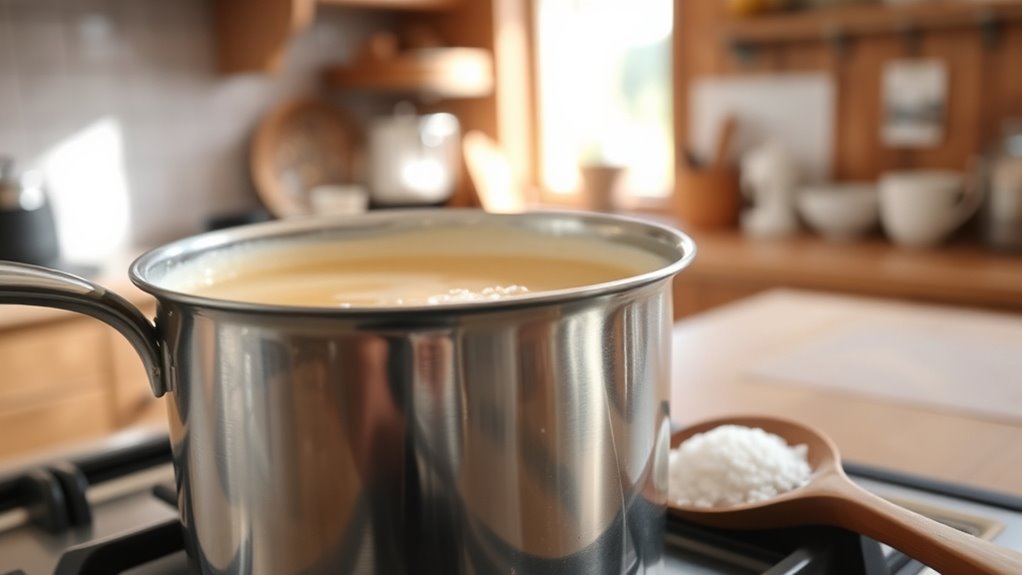How to Make a Spanish Latte (Cafe Con Leche)
To make a Spanish latte, start by pulling a strong espresso shot using freshly ground dark roast beans. Heat whole or oat milk to about 150°F, then froth it into a creamy microfoam. Mix the espresso with sweetened condensed milk for that signature rich sweetness, using roughly a 1:2 ratio. Pour the frothed milk over the blend, creating a smooth, velvety texture. For tips on perfect frothing, serving, and tasty variations, keep exploring.
What Is a Spanish Latte?

A Spanish latte is a rich, creamy coffee drink that combines strong espresso with steamed milk and a generous amount of sweetened condensed milk. When you savor a Spanish latte, you’re embracing a beverage with deep cultural origins rooted in Spain and Latin America, where coffee culture is a daily ritual. This drink distinguishes itself by its sweet, velvety profile, a result of condensed milk’s unique texture and flavor. It offers a balanced intensity that respects the boldness of espresso while delivering smoothness and sweetness, perfect if you crave both strength and comfort in your cup. Understanding the Spanish latte’s cultural origins lets you appreciate how tradition and taste freedom merge, inviting you to enjoy coffee beyond conventional limits.
Essential Ingredients for a Spanish Latte
To craft an authentic Spanish latte, you’ll need to start with rich, strong espresso as your coffee base. Choosing the right milk—whether whole, condensed, or evaporated—will greatly influence the drink’s texture and sweetness. Finally, selecting an appropriate sweetener, like traditional sugar or a more nuanced alternative, completes the balance of flavors essential to this beverage.
Key Coffee Components
Understanding the key coffee components is essential for crafting an authentic Spanish latte that balances boldness and sweetness. Start by selecting coffee beans with a distinct coffee origin—typically, beans from Latin America or Spain offer rich, nutty profiles that complement the drink’s creamy texture. Your brewing techniques also play a pivotal role; espresso is traditional, delivering concentrated flavor and a robust body. Whether you use an espresso machine or a stovetop moka pot, aim for a precise extraction to avoid bitterness or sourness. The grind size and water temperature should be carefully controlled to preserve the coffee’s natural oils and aromatic compounds. Mastering these elements lets you release the freedom to create a Spanish latte that’s both vibrant and smooth, reflecting true craftsmanship.
Milk Selection Tips
Once you’ve mastered the coffee base, the next step is selecting the right milk to achieve that creamy, velvety texture characteristic of a Spanish latte. Milk fat plays a significant role here—higher fat content enhances richness and mouthfeel. However, if you prefer milk alternatives, many can deliver similar creaminess without dairy.
| Milk Type | Characteristics |
|---|---|
| Whole Milk | High milk fat, creamy texture |
| Almond Milk | Lower milk fat, nutty flavor |
| Oat Milk | Moderate milk fat, smooth taste |
Choose based on your texture preference and dietary needs. Whole milk offers classic richness, while oat milk provides a balanced creaminess. Almond milk suits those seeking a lighter, flavored twist. Experiment freely to find your ideal milk partner for that perfect Spanish latte.
Sweetener Options
Although the milk you choose shapes the texture of your Spanish latte, the sweetener you add defines its signature flavor profile. You can opt for natural sweeteners like honey or agave, which impart subtle floral or earthy notes while keeping your latte wholesome. These choices let you control sweetness without artificial additives, enhancing the coffee’s richness. If you want to experiment, flavored syrups such as vanilla or caramel add complexity and a touch of indulgence, perfect for crafting a unique café con leche experience. Remember, the key is balance—too much sweetness can overpower the espresso’s boldness. By selecting your sweetener thoughtfully, you maintain freedom to tailor your Spanish latte exactly to your taste, elevating every sip into a personalized ritual.
Choosing the Right Coffee Beans
Selecting the right coffee beans is essential for crafting an authentic Spanish latte that balances boldness and sweetness. You’ll want beans that deliver a robust flavor profile to complement the creamy milk and sugar. Here’s what to evaluate:
- Opt for a dark roast: Dark roast beans bring out deep, rich flavors and reduce acidity, perfect for a Spanish latte’s smooth character.
- Check the origin: Beans from Latin America or Spain tend to have chocolatey and nutty notes, enhancing the latte’s complexity.
- Freshness matters: Always choose freshly roasted beans to preserve the essential oils and nuanced flavors that define a quality cup.
How to Brew the Perfect Espresso

To brew the perfect espresso for your Spanish latte, start with freshly ground, high-quality coffee beans that suit your taste profile. You’ll also need to fine-tune your espresso machine settings, including grind size, water temperature, and extraction time, to achieve the ideal balance of flavor and crema. Mastering these elements guarantees a rich, smooth espresso base that complements the sweetened condensed milk perfectly.
Choosing Quality Coffee Beans
When you want to brew the perfect espresso for your Spanish latte, the quality of your coffee beans plays a crucial role. Selecting beans with the right coffee origin and flavor profile guarantees a rich, authentic taste. Here’s what to focus on:
- Coffee Origin: Choose beans from regions known for bold, balanced flavors like Colombia or Ethiopia. These origins influence the espresso’s character.
- Roast Level: Opt for a medium to dark roast to complement the creamy milk in your latte without overpowering it.
- Freshness: Always pick freshly roasted beans, ideally used within two weeks of roasting, to capture vibrant aromas and full flavor.
Espresso Machine Settings
Dialing in the right espresso machine settings is essential for extracting the perfect shot that forms the base of your Spanish latte. Start by confirming your espresso machine maintenance is up to date; clean group heads and regularly descale to prevent flavor interference. Focus on brewing temperature adjustments—aim for a stable range between 195°F and 205°F, as slight variations can dramatically affect extraction balance. Adjust grind size and dose accordingly to maintain a 25-30 second extraction time, which yields ideal flavor without bitterness. Monitor water pressure, ideally around 9 bars, to guarantee consistent flow. Mastering these precise settings grants you control, allowing your espresso to deliver rich, nuanced taste, providing the freedom to craft a Spanish latte that’s perfectly tailored to your palate every time.
Preparing the Sweetened Milk

Although it may seem straightforward, preparing the sweetened milk is an essential step that defines the authentic flavor of a Spanish latte. You’ll want to focus on balancing milk sweetness with the ideal milk texture to achieve that signature smoothness. Here’s how to nail it:
- Choose whole milk for a creamy base that enhances sweetness naturally.
- Add sweetener gradually—typically equal parts sugar to milk—to control milk sweetness precisely without overpowering the espresso.
- Steam the milk carefully, creating microfoam for a velvety milk texture that blends seamlessly with the coffee.
Mastering these steps lets you enjoy the freedom to customize your latte’s sweetness and texture, crafting a truly authentic cafe con leche experience at home.
Combining Espresso and Milk
Since the espresso and sweetened milk are both ready, you’ll want to combine them carefully to preserve the balance of flavors and textures that make a Spanish latte unique. Start by pouring the espresso into your cup, mindful of espresso ratios—typically one part espresso to two parts milk—to avoid overpowering bitterness or excessive sweetness. Next, gently add the warm, sweetened milk, ensuring the milk textures remain smooth and velvety rather than frothy or flat. Pouring slowly allows the milk to blend seamlessly with the espresso, creating a harmonious fusion. The goal is a creamy, rich latte where neither component dominates. Mastering this balance grants you the freedom to savor a perfectly crafted café con leche, honoring its traditional essence with every sip.
Tips for Frothing Milk at Home
To achieve the perfect froth for your Spanish latte, focus on mastering your milk frothing technique, whether using a steam wand or a handheld frother. Choosing the right milk—whole milk for creaminess or oat milk for a plant-based alternative—also impacts texture and taste. With the right method and milk, you’ll create a smooth, velvety foam that enhances your espresso’s flavor.
Milk Frothing Techniques
Mastering three essential milk frothing techniques will elevate your Spanish latte to café-quality perfection. Frothed milk is the soul of your drink, so getting it right is vital. Here’s how to refine your steaming techniques:
- Temperature Control: Heat your milk to about 150°F (65°C). Too hot, and it scorches; too cold, and it won’t froth properly.
- Aeration: Introduce air by positioning your steam wand just below the surface. This creates microfoam, giving your milk a creamy texture without large bubbles.
- Texture Integration: After frothing, tap the pitcher on the counter to settle the foam, then swirl gently to blend the milk and foam seamlessly.
Best Milk Types
Choosing the right milk is essential for achieving the perfect froth and flavor in your Spanish latte. Whole milk is a classic choice, offering a creamy texture and rich taste that froths beautifully. If you prefer plant-based options, oat milk stands out for its natural creaminess and ability to create a velvety froth without overpowering the coffee’s flavor. Almond milk, while lighter, can be frothed effectively if you select barista blends designed for steaming. Avoid low-fat or skim milk, as they generally produce less stable foam. When frothing at home, make sure your milk is fresh and cold to optimize texture. Experiment with these options to find what suits your taste and lifestyle, giving you freedom to craft your ideal Spanish latte every time.
Serving Suggestions and Presentation
How should you present your Spanish latte to highlight its rich, creamy texture and bold flavors? Focus on the right serving vessels and garnishing options to elevate the experience. Here’s how you can do it:
- Choose the perfect vessel: Opt for a clear glass cup or a traditional ceramic mug to showcase the latte’s layered look and warmth. Transparency adds visual appeal and invites you to savor every sip.
- Add thoughtful garnishes: Sprinkle cinnamon or nutmeg lightly on top for an aromatic touch, or add a thin orange peel twist to complement the coffee’s sweetness.
- Serve with intention: Present your latte on a small wooden tray with a biscotti or shortbread cookie to enhance the tactile and taste experience.
These steps help you embrace freedom in presentation while honoring the Spanish latte’s character.
Variations of the Spanish Latte

Presenting your Spanish latte with care sets the stage for exploring its many variations, each offering a unique twist on the classic recipe. You might try a cinnamon twist by sprinkling freshly ground cinnamon atop your latte or stirring in a cinnamon stick during brewing to add warm, aromatic complexity. Alternatively, a subtle vanilla infusion can elevate the drink’s sweetness and depth; simply add a splash of vanilla syrup or a few drops of vanilla extract to your milk before steaming. For a richer experience, experiment with different milk types—almond or oat milk complement the latte’s robust espresso. These variations allow you to tailor your Spanish latte to your mood and palate, giving you the freedom to enjoy this beloved beverage in countless personalized ways.
Storing and Reheating Leftover Spanish Latte
Although a freshly made Spanish latte is always perfect, you might find yourself with leftovers that deserve proper storage to preserve their flavor and texture. For effective leftover storage, follow these steps:
- Cool Quickly: Let your Spanish latte cool to room temperature before transferring it to an airtight container.
- Refrigerate Promptly: Store the container in the refrigerator within two hours to maintain freshness and prevent bacterial growth.
- Use Within 24 Hours: Consume your leftover Spanish latte within a day for best taste and safety.
When it’s time to enjoy your latte again, reheating methods matter. Gently warm it on the stove over low heat or use a microwave in short intervals, stirring frequently to retain creaminess and prevent scorching. Avoid boiling to preserve the delicate balance of espresso and sweetened milk.
Frequently Asked Questions
Can I Use a Milk Alternative for a Spanish Latte?
They say variety is the spice of life, and that’s true when it comes to milk alternatives in your coffee. You can definitely use almond, oat, or soy milk for a Spanish latte, creating unique flavor variations that suit your taste and dietary needs. Just remember each alternative behaves differently when heated, so choose one that froths well to maintain that creamy texture you love, giving you the freedom to enjoy your latte your way.
How Early Can I Prepare a Spanish Latte Before Serving?
You can make ahead your Spanish latte up to a few hours before serving, but it’s best to keep espresso and milk separate until ready to combine for freshness. For storage tips, refrigerate the milk or milk alternative and keep the espresso in a sealed container at room temperature for up to an hour. When you’re ready, gently reheat the milk, pour espresso over it, and enjoy that rich, comforting freedom in every sip.
Is Spanish Latte Suitable for Children?
You might want to be cautious about serving a Spanish latte to children because of its caffeine content, which can affect their sleep and behavior. If you’re looking for child friendly options, consider using decaffeinated espresso or substituting with steamed milk and a touch of vanilla for sweetness. This way, you can still offer a tasty, warm drink without the potential side effects of caffeine on kids.
What Is the Origin of the Spanish Latte?
You’ll find that Spanish coffee, including the Spanish latte, has deep roots in Latin culture, where coffee drinking is a cherished daily ritual. Originating in Spain and spreading throughout Latin America, this rich, milky coffee reflects the region’s love for bold flavors and communal moments. Understanding its origin helps you appreciate how the Spanish latte isn’t just a drink—it’s a symbol of cultural freedom and connection.
Can I Make a Spanish Latte Without an Espresso Machine?
You can definitely make a Spanish latte without an espresso machine by using alternative brewing methods like a moka pot or AeroPress to get a strong coffee base. If you lack those, coffee substitutes such as instant espresso powder or concentrated coffee work well too. Just brew strong, then combine it with scalded milk and sweetened condensed milk for that authentic rich, creamy flavor. This way, you enjoy freedom in your coffee routine without specialized gear.






